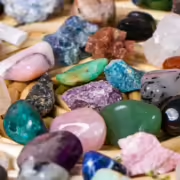Amazonite: Properties, Uses and Virtues
In this fascinating exploration of Amazonite, we delve into its geological origins, reveal the magnificence of crystals in their raw state, and explore the dazzling spread of this stone around the world. Along the way, we’ll unravel the threads of its enigmatic history, offering an in-depth look at this unique and mysterious gem.

- Geological formation of Amazonite
- Rough Amazonite – Natural Radiance Revealed
- Sources – Amazonite Worldwide Presence
- Historical Significance of Amazonite – A Mystical Heritage
- Metaphysical properties of Amazonite – Serenity energy
- Amazonite varieties
- Amazonite colors
- Durability and portability of Amazonite
- Amazonite Enhancements – Preserving its Natural Splendor
- Synthetic Amazonite – Nature in the Lab
- Amazonite Imitations – Distinguishing the Authentic
- Amazonite care – Preserving its beauty
Geological formation of Amazonite
The geological formation of Amazonite is a fascinating process that results from specific geological conditions over vast periods of time. Amazonite is a variety of microcline, a type of potassium feldspar, which forms mainly in pegmatites, mineral-rich magmatic rocks. These pegmatites are generally formed during the slow crystallization of magma, allowing the minerals to develop into large crystals.
Over time, hydrothermal fluids rich in elements such as potassium and lead migrate through fractures and cracks in the surrounding rocks. These fluids can react with feldspar, causing chemical changes that lead to the formation of Amazonite. The presence of lead and water in these fluids plays a crucial role in the development of Amazonite’s characteristic color, which varies from pale green to turquoise green.
Rough Amazonite – Natural Radiance Revealed
Like many polycrystalline minerals, Amazonite is most often found as massive crystals, which can be polished to reveal their characteristic luster.
Sources – Amazonite Worldwide Presence
Amazonite deposits are often found in granitic regions where pegmatites are abundant. Areas of the world known for their Amazonite deposits include Brazil, Peru, Russia, the USA (mainly Colorado) and Ethiopia, although smaller occurrences can be found in other parts of the world.
Historical Significance of Amazonite – A Mystical Heritage
Amazonite has a rich and fascinating history going back thousands of years, making it a gemstone deeply rooted in the cultures and beliefs of many civilizations. Its soothing beauty and varied shades have attracted human attention since ancient times, leading to its widespread use in jewelry, ornaments and ritual objects.
- Ancient civilizations of Mesopotamia and Egypt: The civilizations of ancient Mesopotamia and Egypt attached great importance to Amazonite. Artefacts containing Amazonite have been discovered in Egypt’s royal tombs, notably those of the pharaohs Ramses II, on view at the Louvre, and Tutankhamun. The Egyptians used Amazonite to make amulets, scarabs and other protective objects, believing in its powers to ward off evil forces and bring good fortune.
- Mayan peoples: The Mayans, a remarkable pre-Columbian civilization that flourished in Central America, were also familiar with Amazonite. Although this stone was not as abundant in their region as in other parts of South America, artifacts containing Amazonite have been discovered in Mayan archaeological sites.
- Amazons and the El Dorado legend: Amazonite takes its name from the legend that it was discovered in the region that was once the territory of the Amazons, the mythical warriors of ancient Greece. Spanish conquistadors, drawn by tales of golden cities such as El Dorado, actively sought out Amazonite in their quest for wealth and power.
- Conquistadors’ discoveries in South America: When the Spanish conquistadors explored South America in the 16th century, they discovered rich deposits of Amazonite in the Andes, notably in Peru and Brazil. They brought these precious stones back to Europe, where they were used to make jewelry for the nobility and high society.
- Native peoples of North and South America: Native peoples of North and South America used Amazonite in their rituals and sacred ceremonies. They believed in its healing and protective properties, as well as its ability to foster spiritual communication. Amazonite was often carved into amulets and talismans, worn as symbols of strength and connection with nature.
- Esoteric traditions and lithotherapy: In modern times, Amazonite continues to be revered for its esoteric properties and therapeutic benefits. Lithotherapy practitioners recommend it to relieve stress, promote communication and strengthen the heart chakra. It is also associated with luck and prosperity, attracting those seeking harmony and abundance in their lives.
Metaphysical properties of Amazonite – Serenity energy
Amazonite is renowned for its metaphysical properties that promote serenity, harmony and clear communication. Its soothing color is associated with emotional healing and energy purification.
Amazonite varieties
Amazonite has no varieties to speak of.
Amazonite colors
Amazonite’s hues range from pale green to turquoise-greenish-blue, sometimes with white or gray inclusions. Its distinct, soothing color makes it a prized gem in the world of jewelry and lithotherapy.
Durability and portability of Amazonite
With a hardness of 6 to 6.5 on the Mohs scale, Amazonite is durable enough to be used in jewelry. However, due to its relative fragility, it should be handled with care to avoid chipping or scratching.
Amazonite Enhancements – Preserving its Natural Splendor
Enhancements to Amazonite aim to preserve its natural splendor while improving its aesthetic characteristics or durability. Here are some commonly used techniques:
- Impregnations: Impregnation involves impregnating Amazonite with a transparent resin or polymer to improve its clarity, color or durability. This technique is often used to stabilize fragile stones containing numerous fractures, or to enhance their resistance to impact and scratching while preserving their natural appearance.
- Tinting: Tinting is sometimes applied to modify or intensify the color of Amazonite. Natural or synthetic colorants are used to create more vibrant hues or to even out the color of the stone. Although staining can produce visually appealing effects, it is important that buyers are informed of any modifications to the stone.
Synthetic Amazonite – Nature in the Lab
Although synthetic Amazonite has been created, it is very rare on the market. You’re more likely to find imitation or real amazonite than synthetic amazonite.
Amazonite Imitations – Distinguishing the Authentic
Amazonite can be imitated using synthetic materials or natural stones dyed to reproduce its color and appearance. The most common culprits are blue-green-tinted howlite and dyed quartz (including agate).
Amazonite care – Preserving its beauty
To preserve the beauty and brilliance of Amazonite, we recommend regular cleaning with a soft, damp cloth.
Avoid prolonged exposure to direct sunlight and harsh chemicals to prevent discoloration or damage.
By following these care tips, you can enjoy the natural splendor of your Amazonite for many years to come.



